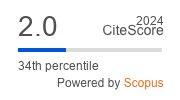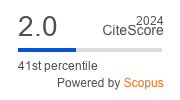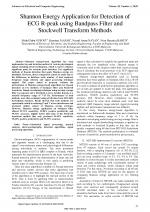| 3/2020 - 5 |
Shannon Energy Application for Detection of ECG R-peak using Bandpass Filter and Stockwell Transform MethodsSUBOH, M. Z. |
| Extra paper information in |
| Click to see author's profile in |
| Download PDF |
Author keywords
biomedical signal processing, spectral analysis, electrocardiography, detection algorithms, signal processing algorithms
References keywords
signal(8), detection(7), transform(5), comput(5), biomed(5), wavelet(4), shannon(4), hilbert(4), energy(4), electrocardiogram(4)
Blue keywords are present in both the references section and the paper title.
About this article
Date of Publication: 2020-08-31
Volume 20, Issue 3, Year 2020, On page(s): 41 - 48
ISSN: 1582-7445, e-ISSN: 1844-7600
Digital Object Identifier: 10.4316/AECE.2020.03005
Web of Science Accession Number: 000564453800005
SCOPUS ID: 85090323119
Abstract
Shannon energy-based algorithm has been implemented in peak detection method of various physiological signals including electrocardiogram, which is used to enhance significant peaks for accurate peak detection. Two significant methods of R-peak detection that apply Shannon energy are identified. However, direct comparison cannot be made due to the differences in database used, number of beat analysed, frequency range selected, and signal processing technique applied. This paper aimed to properly evaluate the performance of Shannon energy-based algorithms for R-peak detection on two methods of bandpass filter and Stockwell transform. Simple enveloping technique using moving average filter is proposed, and a threshold is set to localize R-peak at a selected frequency range of 7-15 Hz. Performance of both methods were then evaluated using all 48 data from MIT-BIH Arrhythmia database. Result showed that both methods are equivalently useful in reducing P and T waves interference and produced similar output of Shannon energy envelope. However, Shannon energy application on bandpass filter offered 99.71% sensitivity, 99.80% positive predictivity and 99.52% accuracy, slightly better than that of the Stockwell transform method that only produced 99.65% sensitivity, 99.68% positive predictivity and 99.33% accuracy. |
| References | | | Cited By «-- Click to see who has cited this paper |
| [1] R. McCraty and F. Shaffer, "Heart rate variability: New perspectives on physiological mechanisms, assessment of self-regulatory capacity, and health risk," Glob. Adv. Heal. Med., vol. 4, no. 1, pp. 46-61, 2015, [CrossRef] [SCOPUS Times Cited 719] [2] P. Laguna et al., "New algorithm for QT interval analysis in 24-hour Holter ECG: performance and applications," Med. Biol. Eng. Comput., vol. 28, no. 1, pp. 67-73, 1990, [CrossRef] [SCOPUS Times Cited 185] [3] P. Laguna, R. Jane, and C. Pere, "Automatic detection of wave boundaries in multilead ECG," Computers and Biomedical Research, vol. 27. pp. 45-60, 1994. [CrossRef] [SCOPUS Times Cited 405] [4] B. Frenay, G. De Lannoy, and M. Verleysen, "Emission modelling for supervised ecg segmentation using finite differences," IFMBE Proc., vol. 22, pp. 1212-1216, 2008, [CrossRef] [SCOPUS Times Cited 6] [5] G. Schreier, D. Hayn, and S. Lobodzinski, "Development of a New QT Algorithm with Heterogenous ECG Databases," J. Electrocardiol., vol. 36, no. SUPPL., pp. 145-150, 2003, [CrossRef] [SCOPUS Times Cited 15] [6] J. A. Vila, Y. Gang, J. M. R. Presedo, M. Fernândez-Delgado, S. Barro, and M. Malik, "A new approach for TU complex characterization," IEEE Trans. Biomed. Eng., vol. 47, no. 6, pp. 764-772, 2000, [CrossRef] [SCOPUS Times Cited 88] [7] R. Gupta, M. Mitra, K. Mondal, and S. Bhowmick, "A derivative-based approach for QT-segment feature extraction in digitized ECG record," Proc. - 2nd Int. Conf. Emerg. Appl. Inf. Technol. EAIT 2011, pp. 63-66, 2011, [CrossRef] [SCOPUS Times Cited 20] [8] I. S. N. Murthy and U. C. Niranjan, "Component wave delineation of ECG by filtering in the Fourier domain," Med. Biol. Eng. Comput., vol. 30, no. 2, pp. 169-176, 1992, [CrossRef] [SCOPUS Times Cited 26] [9] H. Li and X. Wang, "Detection of electrocardiogram characteristic points using lifting wavelet transform and Hilbert transform," Trans. Inst. Meas. Control, vol. 35, no. 5, pp. 574-582, 2013, [CrossRef] [SCOPUS Times Cited 43] [10] K. Friganovic, D. Kukolja, A. Jovic, M. Cifrek, and G. Krstacic, "Optimizing the Detection of Characteristic Waves in ECG Based on Processing Methods Combinations," IEEE Access, vol. 6, 2018, [CrossRef] [SCOPUS Times Cited 24] [11] J. P. Martinez, R. Almeida, S. Olmos, A. P. Rocha, and P. Laguna, "A Wavelet-Based ECG Delineator Evaluation on Standard Databases," IEEE Trans. Biomed. Eng., vol. 51, no. 4, pp. 570-581, 2004, [CrossRef] [SCOPUS Times Cited 1407] [12] J. P. V. Madeiro, P. C. Cortez, J. A. L. Marques, C. R. V. Seisdedos, and C. R. M. R. Sobrinho, "An innovative approach of QRS segmentation based on first-derivative, Hilbert and Wavelet Transforms," Med. Eng. Phys., vol. 34, no. 9, pp. 1236-1246, 2012, [CrossRef] [SCOPUS Times Cited 102] [13] M. S. Manikandan and K. P. Soman, "A novel method for detecting R-peaks in electrocardiogram (ECG) signal," Biomed. Signal Process. Control, vol. 7, no. 2, pp. 118-128, 2012, [CrossRef] [SCOPUS Times Cited 364] [14] R. Kumar, A. Kumar, and G. K. Singh, "Electrocardiogram signal compression based on 2D-transforms: A research overview," J. Med. Imaging Heal. Informatics, vol. 6, no. 2, pp. 285-296, 2016, [CrossRef] [SCOPUS Times Cited 24] [15] D. Benitez, P. A. Gaydecki, A. Zaidi, and A. P. Fitzpatrick, "The use of the Hilbert transform in ECG signal analysis," Comput. Biol. Med., vol. 31, no. 5, pp. 399-406, 2001, [CrossRef] [SCOPUS Times Cited 428] [16] M. R. Homaeinezhad, A. Ghaffari, H. Najjaran Toosi, M. Tahmasebi, and M. M. Daevaeiha, "A Unified Framework for Delineation of Ambulatory Holter ECG Events via Analysis of a Multiple-Order Derivative Wavelet-Based Measure," Iran. J. Electr. Electron. Eng., vol. 7, no. 1, pp. 1-18, 2011 [17] Z. Zidelmal, A. Amirou, D. Ould-Abdeslam, A. Moukadem, and A. Dieterlen, "QRS detection using S-Transform and Shannon energy," Comput. Methods Programs Biomed., vol. 116, no. 1, pp. 1-9, 2014, [CrossRef] [SCOPUS Times Cited 128] [18] H. Zhu and J. Dong, "An R-peak detection method based on peaks of Shannon energy envelope," Biomed. Signal Process. Control, vol. 8, no. 5, pp. 466-474, 2013, [CrossRef] [SCOPUS Times Cited 73] [19] H. Beyramienanlou and N. Lotfivand, "Shannon's Energy Based Algorithm in ECG Signal Processing," Comput. Math. Methods Med., vol. 2017, 2017, [CrossRef] [SCOPUS Times Cited 45] [20] O. Navin, G. Kumar, N. Kumar, K. Baderia, R. Kumar, and A. Kumar, "R-peaks detection using shannon energy for HRV analysis," Lect. Notes Electr. Eng., vol. 526, pp. 401-409, 2019, [CrossRef] [SCOPUS Times Cited 3] [21] G. B. Moody and R. G. Mark, "The impact of the MIT-BIH arrhythmia database," IEEE Eng. Med. Biol. Mag., vol. 20, no. 3, pp. 45-50, 2001, [CrossRef] [SCOPUS Times Cited 3676] [22] I. Silva and G. B. Moody, "An Open-source Toolbox for Analysing and Processing PhysioNet Databases in MATLAB and Octave," J. Open Res. Softw., vol. 2, pp. 2-5, 2014, [CrossRef] [23] A. L. Goldberger et al., "PhysioBank, PhysioToolkit, and PhysioNet: Components of a New Reseach Resource for COmplex Physiologic Signals," Circulation, vol. 101, no. 23, 2000, [CrossRef] [24] N. A. Nayan and H. A. Hamid, "Evaluation of patient electrocardiogram datasets using signal quality indexing," Bull. Electr. Eng. Informatics, vol. 8, no. 2, pp. 521-528, 2019, [CrossRef] [SCOPUS Times Cited 10] [25] L. G. Tereshchenko and M. E. Josephson, "Frequency content and characteristics of ventricular conduction," J. Electrocardiol., vol. 48, no. 6, pp. 933-937, 2015, [CrossRef] [SCOPUS Times Cited 110] [26] A. A. Fedotov, A. S. Akulova, and S. A. Akulov, "Effective QRS-detector based on Hilbert transform and adaptive thresholding," IFMBE Proc., vol. 57, no. October, pp. 140-144, 2016, [CrossRef] [SCOPUS Times Cited 9] [27] M. Elgendi, M. Jonkman, and F. Deboer, "Frequency bands effects on QRS detection," BIOSIGNALS 2010 - Proc. 3rd Int. Conf. Bio-inpsired Syst. Signal Process. Proc., no. 2002, pp. 428-431, 2010. [28] J. E. Poole, J. P. Singh, and U. Birgersdotter-Green, "QRS duration or QRS morphology what really matters in cardiac resynchronization therapy?," J. Am. Coll. Cardiol., vol. 67, no. 9, pp. 1104-1117, 2016, [CrossRef] [SCOPUS Times Cited 81] Web of Science® Citations for all references: 0 SCOPUS® Citations for all references: 7,991 TCR Web of Science® Average Citations per reference: 0 SCOPUS® Average Citations per reference: 276 ACR TCR = Total Citations for References / ACR = Average Citations per Reference We introduced in 2010 - for the first time in scientific publishing, the term "References Weight", as a quantitative indication of the quality ... Read more Citations for references updated on 2025-07-01 08:06 in 172 seconds. Note1: Web of Science® is a registered trademark of Clarivate Analytics. Note2: SCOPUS® is a registered trademark of Elsevier B.V. Disclaimer: All queries to the respective databases were made by using the DOI record of every reference (where available). Due to technical problems beyond our control, the information is not always accurate. Please use the CrossRef link to visit the respective publisher site. |
Faculty of Electrical Engineering and Computer Science
Stefan cel Mare University of Suceava, Romania
All rights reserved: Advances in Electrical and Computer Engineering is a registered trademark of the Stefan cel Mare University of Suceava. No part of this publication may be reproduced, stored in a retrieval system, photocopied, recorded or archived, without the written permission from the Editor. When authors submit their papers for publication, they agree that the copyright for their article be transferred to the Faculty of Electrical Engineering and Computer Science, Stefan cel Mare University of Suceava, Romania, if and only if the articles are accepted for publication. The copyright covers the exclusive rights to reproduce and distribute the article, including reprints and translations.
Permission for other use: The copyright owner's consent does not extend to copying for general distribution, for promotion, for creating new works, or for resale. Specific written permission must be obtained from the Editor for such copying. Direct linking to files hosted on this website is strictly prohibited.
Disclaimer: Whilst every effort is made by the publishers and editorial board to see that no inaccurate or misleading data, opinions or statements appear in this journal, they wish to make it clear that all information and opinions formulated in the articles, as well as linguistic accuracy, are the sole responsibility of the author.



